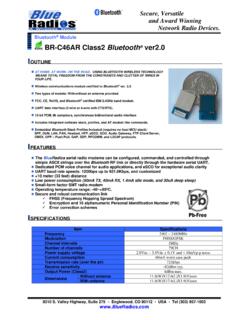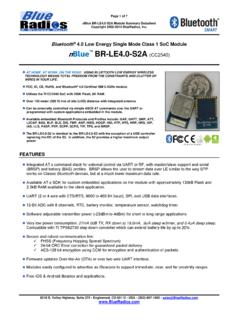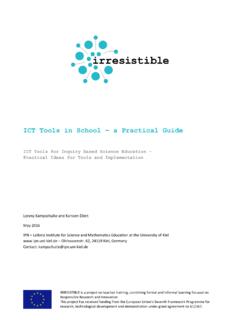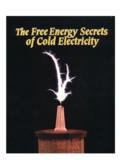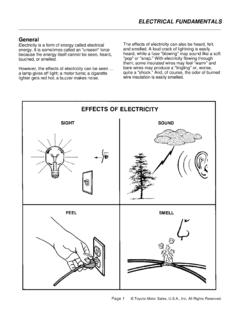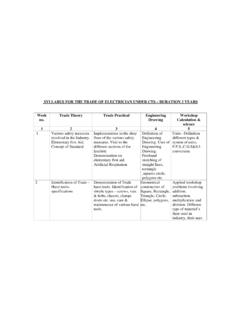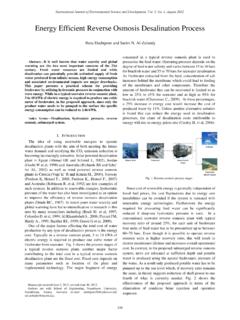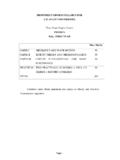Transcription of 4.0 Low Energy Single Mode Class 1 SoC USB Serial Dongle ...
1 Page 1 of 5. nBlue Dongle Summary Datasheet Copyright 2002-2014 BlueRadios, Inc. Bluetooth Low Energy Single Mode Class 1 SoC USB Serial Dongle nBlue (CC2540). TM. AT HOME. AT WORK. ON THE ROAD. USING BLUETOOTH LOW Energy . WIRELESS TECHNOLOGY MEANS TOTAL FREEDOM FROM THE CONSTRAINTS. AND CLUTTER OF WIRES IN YOUR LIFE. FCC, IC, CE, RoHS, and Bluetooth Certified ISM module. Utilizes the TI CC2540 SoC with 256K Flash, 8K RAM. Over 150 meter (500 ft) line of site (LOS) distance with integrated chip antenna. Can be externally controlled via simple ASCII AT commands over the UART or programmed with custom applications embedded in the module. Available embedded Bluetooth Protocols and Profiles include: GAP, GATT, SMP, ATT, L2 CAP, BAS, BLP, BLS, DIS, FMP, ANP, HIDS, HOGP, HID, HTP, HTS, HRP, HRS, IOP, IAS, LLS, PASP, PXP, SCPP, SCPS, TIP, TPS, and BRSP. nBlue module The module is identical to the with the exception of a USB.
2 Controller replacing the I2C of the S3. In addition, the S2 provides a higher maximum output power. LED status indicators: USB Power (red), PIO2 Bluetooth Connection (blue), and PIO5. Slave status (green). USB system-on-chip FTDI controller, no custom software driver installation required. Included: translucent blue ABS plastic enclosure. 30(L) X 18(W) X 10(H)mm ( " X " X "). FEATURES. Integrated command stack for external control via UART or RF, with master/slave support and Serial (BRSP) and battery (BAS) profiles. BRSP allows the user to stream data over LE similar to the way SPP. works on Classic Bluetooth devices, but at a much lower maximum data rate. Available SDK for custom embedded applications on the module with approximately 130kB Flash and RAM available to the client application. UART (2 or 4 wire with CTS/RTS, 9600 to baud), SPI, and USB data interfaces. 12-Bit ADC with 8 channels, RTC, battery monitor, temperature sensor, watchdog timer.
3 Software adjustable transmitter power (-23dBm to 4dBm) for short to long range applications. Secure and robust communication link: FHSS (Frequency Hopping Spread Spectrum). 24-bit CRC Error correction for guaranteed packet delivery AES-128 bit encryption using CCM for encryption and authentication of packets. Firmware updates Over-the-Air (OTA) or over two wire UART interface. Free iOS & Android libraries and applications. Supports iBeacon. 8310 S. Valley Highway, Suite 275 Englewood, CO 80112 USA (303)-957-1003 Page 2 of 5. nBlue Dongle Summary Datasheet Copyright 2002-2014 BlueRadios, Inc. FIRMWARE OPTIONS. 1. Command Set for external control via UART or RF. 2. SDK for custom embedded applications, which requires the IAR Systems Compiler. APPLICATIONS. - Telemedicine / Telehealth - Health Care and Medical - Medical Patient Monitoring - Smart Grid - Human Interface Devices (Keyboard, - Automated Meter Reading (AMR).)
4 Mouse, Remote control) - Home/Building Automation - Sports and leisure equipment - Machine-to-Machine (M2M). - Mobile phone accessories - Wireless Sensor Networks - Remote controls - Wireless Alarms and Security - Consumer Electronics - Lighting and HVAC control - Remote monitoring and control - Proximity and out of range detection (iBeacon). LOW Energy VS CLASSIC BLUETOOTH. - Broadcast support - 10 msec. connect time and low data latency - Connectionless always off technology - First low power wireless technology standard - Proximity and out of range detection Bluetooth Low Energy , part of Bluetooth Ver. , specifies two types of implementation: Single mode and dual mode. Single mode chips implement the low Energy specification and consume just a fraction of the power of classic Bluetooth, allowing the short-range wireless standard to extend to coin cell battery applications for the first time.
5 Dual mode chips combine low Energy with the power of classic Bluetooth and are likely to become a de facto feature in almost all new Bluetooth enabled cellular phones and computers. Single mode Bluetooth Low Energy is NOT backwards compatible with previous Bluetooth standards. Dual mode Bluetooth Low Energy is backwards compatible but is not practical for low power devices but targeted to gateway products. An nBlue Single mode module communicating over BLE once a second consumes ~30 A on average. To put this in perspective, 30 A corresponds to 330 days of battery life using a CR2032 coin cell. BLE is not recommended for data streaming applications but is ideal for efficient short (20 byte or less) packet bursts. In LE, GAP defines four specific roles: Broadcaster, Observer, Peripheral, and Central. A device may support multiple LE GAP roles provided that the underlying Controller supports those roles or role combinations.
6 However, only one LE GAP role may be supported at a given time. The Broadcaster role is optimized for transmitter only applications. Devices supporting the broadcaster role use advertising to broadcast data. The broadcaster role does not support connections. The Observer role is optimized for receiver only applications. Devices supporting the observer role are the complementary device for a broadcaster and receives broadcast data contained in advertisements. The observer role does not support connections. The Peripheral role is optimized for devices that support a Single connection and are less complex than central devices. Devices supporting the peripheral role only require Controllers that support the Controller's slave role. The Central role supports multiple connections and is the initiator for all connections with devices in the peripheral role. Devices supporting the central role require a Controller that supports the Controller's master role and generally supports more complex functions compared to the other LE GAP roles.
7 8310 S. Valley Highway, Suite 275 Englewood, CO 80112 USA (303)-957-1003 Page 3 of 5. nBlue Dongle Summary Datasheet Copyright 2002-2014 BlueRadios, Inc. SPECIFICATIONS SUMMARY (Module only). Operating Conditions Summary Item Specifications Supply voltage (VDD) V. VDD ripple 100 mV Max Max voltage on any pin VDD + .3 V (Not 5V Tolerant). Ambient Temperature Range -40 85 C. Current Consumption Summary Measurements done at TA = 25 C, VDD = 3 V. Item Specifications Specifications w/ TPS62730. Power Mode 3 (120 s Wake-Up) A A. Power Mode 2 (120 s Wake-Up) A A. Power Mode 1 (4 s Wake-Up) 235 A 235 A. Low MCU Activity mA mA. RX Standard Gain mA mA. RX High Gain mA mA. TX -23 dBm mA mA. TX -6 dBm mA mA. TX 0 dBm 27 mA 21 mA. TX 4 dBm mA mA. RF Specifications Summary Item Specifications Frequency 2402 2480 MHz in 2 Mhz steps Data Rate and Modulation 1 Mbps, GFSK. Number of Channels 40: 37 data / 3 advertising (0,12,39).
8 Receive Sensitivity (w/chip antenna) -96/-90 dBm Output Power -23 to 0 dBm Link Budget Up to 96dB. RX/TX Turnaround 150 us 8310 S. Valley Highway, Suite 275 Englewood, CO 80112 USA (303)-957-1003 Page 4 of 5. nBlue Dongle Summary Datasheet Copyright 2002-2014 BlueRadios, Inc. DEBUGGING. PIO_4 and PIO_7 also function as the Debug Data (DD) and Debug Clock (DC) lines, allowing the modules to be connected to a TI CC-Debugger for debugging and programming. See the CC Debugger User's Guide for more information: An nBlue Interace Board (IB) is also available and allows the user to debug, program, update firmware and have UART communications with any of the nBlue modules through a Single or double row 10 pin header. See the nBlue Module User's Guide for more information. A CC-DEBUGGER is only needed for writing a custom application for a module and not using the command set, firmware can be updated without a debugger.
9 8310 S. Valley Highway, Suite 275 Englewood, CO 80112 USA (303)-957-1003 Page 5 of 5. nBlue Dongle Summary Datasheet Copyright 2002-2014 BlueRadios, Inc. ORDERING INFORMATION. Pricing and ordering information can be found at: PART NUMBER. BR = BlueRadios MUSB = Mini Universal Serial BUS. LE = Low Energy = Bluetooth LE version S = Single Mode 2 = Class 1 SoC Module +150 meter (CC2540). 3 = Class 2 SoC Module +100 meter (CC2541) special order A = Antenna Part Number Description 1. Bluetooth Low Energy Single Mode with Antenna STANDARD PACKAGING. Bulk DEVELOPMENT KIT ( ). Development kit available containing everything required to set up a connection quickly and evaluate range and performance of the : CUSTOM FIRMWARE. The command interface can be modified for high volume customers and custom embedded software development is available upon request ADDITIONAL DOCUMENTATION. Complete OEM documentation can be found at: Requires proof of purchase.
10 8310 S. Valley Highway, Suite 275 Englewood, CO 80112 USA (303)-957-1003
